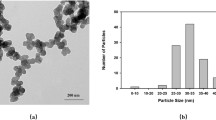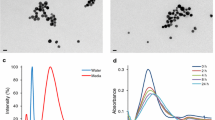Abstract
Nanosilver is produced in various shapes, size and coatings to increase its nanomaterial effects. However, the nanotoxicity related with the physiochemical properties of nanomaterials. When nanomaterials attach, reacted or be though the cell membrane, the first barriers they face are cell proteins (e.g., receptors, enzymes, and carriers). Nanomaterials could affect metabolic mechanisms through their reaction with cell proteins. Therefore, this study analyzed changes in metabolic processes to identify corresponding changes in molecular functions and biological processes. We compared the gene expression profiling results of zebrafish embryos exposed to silver nanocolloids (Ag NCs, 10 μg/L) and silver nanotubes (Ag NTs, 1 μg/L); the results revealed that 198 genes were upregulated and 99 downregulated by Ag NCs and Ag NTs. The major genes of molecular function were associated with binding and catalytic activity, and the related genes of biological processes were involved in nucleobase-containing compound and protein metabolic processes. This study suggests that the two types of nanosilver caused similar patterns of metabolic process change regardless of nanosilver shape.
Similar content being viewed by others
References
Choi, Y. S., Lee, M. Y., David, A. E. & Park, Y. S. Nanoparticles for gene delivery: therapeutic and toxic effects. Mol Cell Toxicol 10:1–8 (2014).
Zhang, L. & Webster, T. J. Nanotechnology and nanomaterials: Promises for improved tissue regeneration. Nano Today 4:66–80 (2009).
Jones, C. F. & Grainger, D. W. In vitro assessments of nanomaterial toxicity. Adv Drug Deliv Rev 61:438–456 (2009).
Sauer, U. G. et al. Applicability of rat precision-cut lung slices in evaluating nanomaterial cytotoxicity, apoptosis, oxidative stress, and inflammation. Toxicol Appl Pharmacol 276:1–20 (2014).
United States Environmental Protection Agency (US EPA), Human Exposure and Atmospheric Sciences; Nanosilver, www.epa.gov/heasd/research/nanosilver.html.
Wijnhoven, S. W. P. et al. Nano-silver — a review of available data and knowledge gaps in human and environmental risk assessment. Nanotoxicology 3:109–138 (2009).
Lapresta-Fernández, A., Fernández, A. & Blasco, J. Nanoecotoxicity effects of engineered silver and gold nanoparticles in aquatic organisms. Trac-Trends Anal Chem 32:40–59 (2012).
Aillon, K. L. et al. Effects of nanomaterial physicochemical properties on in vivo toxicity. Adv Drug Deliv Rev 61:457–466 (2009).
Mahmoudi, M. et al. Interaction of stable colloidal nanoparticles with cellular membranes. Biotechnol Adv 32:679–692 (2014).
Walkey, C. D. & Chan, W. C. Understanding and controlling the interaction of nanomaterials with proteins in a physiological environment. Chem Soc Rev 41:2780–2799 (2012).
Ghosh, M. et al. In vitro and in vivo genotoxicity of silver nanoparticles. Mutat Res 749:60–69 (2012).
Dobrzyńska, M. M. et al. Genotoxicity of silver and titanium dioxide nanoparticles in bone marrow cells of rats in vivo. Toxicology 315:86–91 (2014).
McShan, D., Ray, P. C. & Yu, H. Molecular toxicity mechanism of nanosilver. J Food Drug Anal 22:116–127 (2014).
Lee, Y. H. et al. Cytotoxicity, oxidative stress, apoptosis and the autophagic effects of silver nanoparticles in mouse embryonic fibroblasts. Biomaterials 35:4706–4715 (2014).
Stępkowski, T. M., Brzóska, K. & Kruszewski, M. Silver nanoparticles induced changes in the expression of NF-κB related genes are cell type specific and related to the basal activity of NF-κB. Toxicol In Vitro 28:473–478 (2014).
Lim, D. H. et al. The effects of sub-lethal concentrations of silver nanoparticles on inflammatory and stress genes in human macrophages using cDNA microarray analysis. Biomaterials 33:4690–4699 (2012).
Xu, L. et al. Genotoxicity and molecular response of silver nanoparticle (NP)-based hydrogel. J Nanobiotechnology 10:16, 1–11 (2012).
Park, H. G. & Yeo, M. K. Comparison of gene expression changes induced by exposure to Ag, Cu-TiO2, and TiO2 nanoparticles in zebrafish embryos. Mol Cell Toxicol 9:129–139 (2013).
Sadeghi, B. et al. Comparison of the anti-bacterial activity on the nanosilver shapes: Nanoparticles, nanorods and nanoplates. Adv Powder Technol 23:22–26 (2012).
Römer, I. et al. Aggregation and dispersion of silver nanoparticles in exposure media for aquatic toxicity tests. J Chromatogr A 1218:4226–4233 (2011).
Angel, B. M., Batley, G. E., Jarolimek, C. V. & Rogers, N. J. The impact of size on the fate and toxicity of nanoparticulate silver in aquatic systems. Chemosphere 93:359–365 (2013).
European Molecular Biology Laboratory — European Bioinformatics Institute (EMBL-EBI), www.ebi.ac.uk/QuickGO/GTerm?id=GO:0044238.
Dekens, M. P. & Whitmore, D. Autonomous onset of the circadian clock in the zebrafish embryo. EMBO J 27:2757–2765 (2008).
Tamai, T. K., Carr, A. J. & Whitmore, D. Zebrafish circadian clocks: cells that see light. Biochem Soc Trans 33:962–966 (2005).
Destici, E., Oklejewicz, M., Nijman, R., Tamanini, F. & van der Horst, G. T. Impact of the circadian clock on in vitro genotoxic risk assessment assays. Mutat Res 680:87–94 (2009).
Palmieri, F. The mitochondrial transporter family SLC25: identification, properties and physiopathology. Mol Aspects Med 34:465–484 (2013).
Lash, L. H. Mitochondrial glutathione transport: physiological, pathological and toxicological implications. Chem Biol Interact 163:54–67 (2006).
Zhao, R. et al. GATA6 is essential for embryonic development of the liver but dispensable for early heart formation. Mol Cell Biol 25:2622–2631 (2005).
Holtzinger, A. & Evans, T. Gata4 regulates the formation of multiple organs. Development 132:4005–4014 (2005).
ZFIN: The Zebrafish Model Organism Database, http://zfin.org/ZDB-GENE-070424-83.
ZFIN: The Zebrafish Model Organism Database, http://zfin.org/ZDB-GENE-070206-10.
Gao, S. et al. Ubiquitin ligase Nedd4L targets activated Smad2/3 to limit TGF-beta signaling. Mol Cell 36:457–468 (2009).
Lacosta, A. M. et al. Pax7 identifies neural crest, chromatophore lineages and pigment stem cells during zebrafish development. Int J Dev Biol 51:327–331 (2007).
Perner, B., Englert, C. & Bollig, F. The Wilms tumor genes wt1a and wt1b control different steps during formation of the zebrafish pronephros. Dev Biol 309:87–96 (2007).
Sperber, S. M. & Dawid, I. B. barx1 is necessary for ectomesenchyme proliferation and osteochondro-progenitor condensation in the zebrafish pharyngeal arches. Dev Biol 321:101–110 (2008).
Darras, V. M., Van Herck, S. L. J., Heijlen, M. & Groef, B. D. Thyroid hormone receptors in two model species for vertebrate embryonic development: chicken and zebrafish. J Thyroid Res 2011:1–8 (2011).
Kim, Y. S., Nakanishi, G., Lewandoski, M. & Jetten, A. M. GLIS3, a novel member of the GLIS subfamily of Krüppel-like zinc finger proteins with repressor and activation functions. Nucleic Acids Res 31:5513–5525 (2003).
Li, J. et al. Phosphorylation of MCM3 protein by cyclin E/cyclin-dependent kinase 2 (Cdk2) regulates its function in cell cycle. J Biol Chem 286:39776–39785 (2011).
Seck, K. et al. Analysis of the DPYD gene implicated in 5-fluorouracil catabolism in a cohort of Caucasian individuals. Clin Cancer Res 11:5886–5892 (2005).
Kessels, M. Y. et al. Proteomics analysis of the zebrafish skeletal extracellular matrix. PLoS one 9:e90568 (2014).
Mracek, P. et al. Regulation of per and cry genes reveals a central role for the D-box enhancer in light-dependent gene expression. PLoS one 7:e51278 (2012).
Baumann, S. et al. An unexpected role for FosB in activation-induced cell death of T cells. Oncogene 22:1333–1339 (2003).
Turchinovich, G. et al. Programming of marginal zone B-cell fate by basic Kruppel-like factor (BKLF/KLF3). Blood 117:3780–3792 (2011).
Seillet, C. et al. Differential requirement for Nfil3 during NK cell development. J Immunol 192:2667–2676 (2014).
Saito, J. et al. Regulation of apoptosis signal-regulating kinase 1 by protein phosphatase 2Cepsilon. Biochem J 405:591–596 (2007).
Westerfield, M. THE ZEBRAFISH BOOK, 5th Edition; A guide for the laboratory use of zebrafish (Danio rerio), Eugene, University of Oregon Press. Paperback. (4th Edition available online, http://zfin.org/zf_info/zfbook/zfbk.html) (2007).
Yeo, M. K. & Park, H. G. Gene expression in zebrafish embryos following exposure to Cu-doped TiO2 and pure TiO2 nanometer-sized photocatalysts. Mol Cell Toxicol 8:127–137 (2012).
Kimmel, C. B. et al. Stages of embryonic development of the zebrafish. Dev Dyn 203:253–310 (1995).
Author information
Authors and Affiliations
Corresponding author
Rights and permissions
About this article
Cite this article
Park, HG., Yeo, MK. Metabolic gene expression profiling of Zebrafish embryos exposed to silver nanocolloids and nanotubes. Mol. Cell. Toxicol. 10, 401–409 (2014). https://doi.org/10.1007/s13273-014-0045-4
Received:
Accepted:
Published:
Issue Date:
DOI: https://doi.org/10.1007/s13273-014-0045-4




